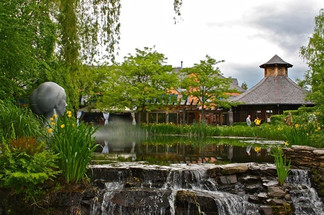Posted by Blue Thumb on Jan 22nd 2025
Creating a Natural-Looking Pond Waterfall in Your Garden
Adding a pond waterfall to your garden can enhance the aesthetic appeal, create soothing sounds, and support a healthy aquatic ecosystem. Designing a waterfall to look natural requires careful planning, the right materials, and attention to detail.
But is there a way you can do it on your own with only some guidance? Doing so can be risky, especially if you have no experience in landscaping or construction. But we here at Blue Thumb can help you add a pond waterfall that blends seamlessly with its surroundings, creating a picturesque water featuare that you’ve always wanted.
Planning Your Waterfall
Choose the Location
The first step is selecting the ideal location for your waterfall. Consider the following:
- Visibility
Choose a spot where the waterfall can be easily seen and enjoyed from various viewpoints in your garden.
- Elevation
Utilize natural slopes or create an elevation using rocks and soil. A gentle slope mimics nature and allows water to cascade more naturally.
- Proximity to Power Source
Ensure the location is close to an electrical outlet for the pump.
Design the Layout
Sketch a rough design of your pond and waterfall. Plan the shape, size, and flow of the waterfall. Consider:
- Water Flow
Decide whether you want a gentle trickle or a robust cascade. This will influence the pump size and the design of the waterfall.
- Levels
Natural waterfalls have multiple levels. Incorporate a series of small drops instead of one large drop for a more natural look.
Gathering Materials
Rocks and Stones
Natural-looking waterfalls require a variety of rocks and stones. Collect different sizes, shapes, and types. Look for the following:
- Boulders
Use large boulders for the base and to create the main structure.
- Flat Stones
Ideal for creating ledges and steps where water can cascade.
- Gravel
Fills gaps and provides a natural transition between different rock layers.
Pond Liner
A pond liner is essential to prevent water from seeping into the ground. Choose a durable, flexible liner that can conform to the shape of your waterfall.
Pump and Tubing
Select a pump that matches the desired flow rate. The tubing will connect the pump to the top of the waterfall. Ensure the pump has enough power to lift water to the desired height.
Underlayment
Underlayment protects the liner from sharp rocks and roots. It adds an extra layer of durability.
Building the Waterfall
Once you have the design and the materials, you need to start the hard work: building the pond waterfall in your garden.
Prepare the Site
Dig out the area for the pond, creating shelves for plants and fish. Then you can shape the waterfall, with a trench for the waterfall’s path, ensuring a gradual slope.
Install the Liner and Underlayment
Lay the underlayment and cover the entire pond and waterfall area with it. Place the liner over the underlayment, making sure it extends beyond the edges of the pond and waterfall to prevent water loss.
Position the Pump and Tubing
Place and submerge the pump in the pond. Ensure it’s accessible for maintenance. Run tubing, making sure to conceal it along the waterfall path, securing it with rocks.
Arrange the Rocks
Start with large boulders at the base layer. Secure them in place to create a stable foundation.
Gradually build up the sides with smaller rocks, creating ledges and steps for the water to cascade over.
If you have flat stones, place them on the ledges to direct water flow. Then fill the gaps with gravel between rocks for a cohesive look.
Give It a Natural Appearance
Plant Selection
Incorporate native plants around the waterfall to blend it with the surrounding landscape. Consider adding aquatic plants such as water lilies, lotuses, and other aquatic plants to enhance the pond’s ecosystem.
You can also add cattails and rushes along the pond’s edge, softening the transition between water and land. Then the addition of terrestrial plants like ferns, hostas, and other moisture-loving plants around the waterfall create a lush, natural look.
Moss and Algae
Encourage moss and algae growth on rocks to give the waterfall an aged, natural appearance. You can do so by transplanting moss, or collecting moss from other areas and placing it on the rocks. Keep it moist to help it establish.
As for algae, it will naturally grow over time, adding to the natural look. Ensure the balance is maintained to avoid excessive algae blooms.
Lighting
Add underwater and surrounding lights to highlight the waterfall’s features and create a magical night time effect. You can use warm, soft lighting for a natural ambiance.
Enjoy Your Pond Waterfall
Once your natural-looking pond waterfall is complete, take the time to enjoy its beauty and tranquility. The soothing sound of cascading water, the sight of fish swimming, and the lush greenery will create a serene outdoor retreat.
Blue Thumb can help you create your dream garden pond that will provide a peaceful oasis for you and your family to enjoy. Visit us now to look for the parts and accessories you need for building and maintenance.

